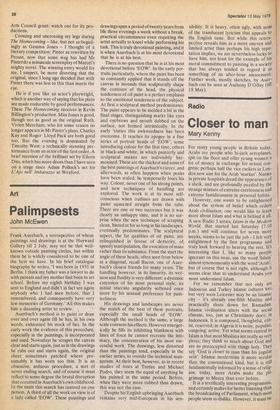Art
Palimpsests
John McEwen
Frank Auerbach, a retrospective of whose paintings and drawings is at the Hayward Gallery till 2 July, may not be that well known outside painting circles, but within them he is widely considered to be one of the best we have. In his brief catalogue biography he writes, 'I was born in 1931 in Berlin. I think my father was a lawyer to do with patents and my mother had been to art school. Before my eighth birthday I was sent to England and didn't in fact see again anybody who I had seen before, that I remembered, and consequently have very few memories of Germany.' All this makes him a daunting artist to review.
Auerbach's method is to paint 'or draw over and over again till he has, in his own words, exhausted his stock of lies. In the early work the evidence of this procedure, especially in the paintings, is incorporated and used. Nowadays he scrapes the canvas clear and starts again, just as in the drawings he rubs out and starts again, the original
sheet sometimes patched where presumably it has worn too thin. It is an
obsessive, arduous procedure, a sort of never ending search, and of course it must reflectio some degree the brutal disruption that occurred in Auerbach's own childhood. In the main this search has centred on one person. A third of all the work on view is of a lady called TOW'. These paintings and drawings span a period of twenty years from life three evenings a week without a break, practical circumstances even requiring the artist actually to kneel while performing his task. This is truly devotional painting, and it is when Auerbach is at his most devotional that he is at his best.
There is no question that he is at his most devotional before TOW'. In the early portraits particularly, where the paint has been so constantly applied that it stands off the canvas in mounds that sculpturally shape the contours of the head, the physical tenderness of oil paint is a perfect emphasis to the emotional tenderness of the subject. At first a sculptural method predominates. The paint appears to be molded a bit in the final stages, distinguishing marks like eyes and eyebrows and mouth dabbed on the surface, not formed intrinsically. In the early 'sixties this awkwardness has been overcome. It reaches its apogee in a fine series of portrait heads of 'EOW', some introducing colour for the first time, others in black-and-white, in which painterly and sculptural means are indivisibly harmonised. These are the thickest and some of the best paintings of Auerbach's career, and afterwards, as often happens when peaks have been scaled, he temporarily loses his way. Colour, never one of his strong points, and new technique,s of handling are explored. The work is at its most selfconscious when outlines are drawn with paint squeezed straight froin the tube. There are one or two successes but it was clearly an unhappy time, and it is no surprise when the new technique of scraping clean, hinted at for so long in his landscapes, eventually predominates. The sculptural aspect, the fat qualities of oil paint, are relinquished in favour of dexterity, of speedy manipulation, the evocation of mass rather than its substance. From the start the angle of these heads, often seen from below at a diagonal, recall Bacon, one of Auerbach's closest friends for many years. The handling however, in its linearity, its wetness and fluidity is very different: a dynamic extension of his most personal style, its initial staccato angularity softened once more by his sensual preference for painterliness.
His drawings and landscapes are never the match of the best of these portraits, especially the small heads of MOW'. Although the method is the same, a large scale coarsens his effects. However energetically he fills its inhibiting blankness with lines of force he cannot recreate the intimacy, the concentration of his most successful work. The drawings, less distorted than the paintings tend, especially in the earlier series, to overdo the technical mannerism. At their best, however, as in recent studies of trees at Tretire and Michael Podro, they seem the equal of anything he has painted in the same period. Before, when they were more rubbed than drawn, this was not the case.
Despite his English upbringing Auerbach remains very mid-European in his sen sibility. It is heavy, often ugly, with none of the translucent lyricism that appeals to the English taste. But while this retrospective reveals him as a more uneven and limited artist than perhaps his high reputation implies, we are nevertheless lucky to have him, not least for the example of his moral commitment to painting in a society that has always tended to regard it as something of an after-hour amusement. Further work, mostly sketches, by Auerbach can be seen at Anthony D'Offay
18 May).


































 Previous page
Previous page